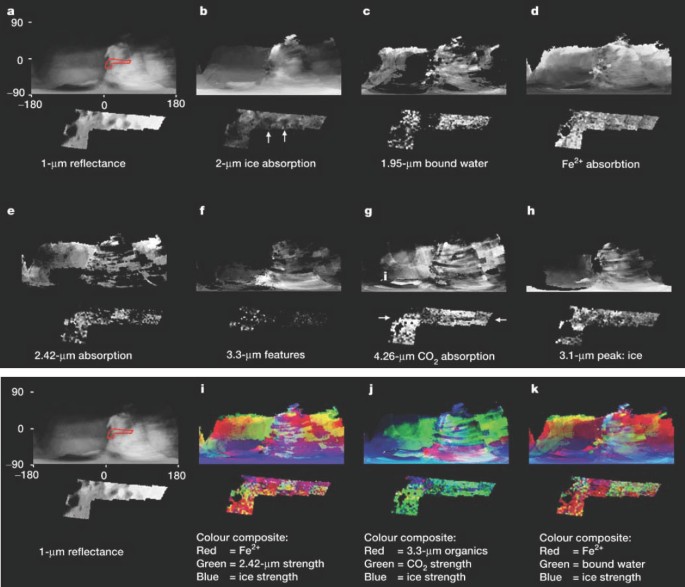
Compositional maps of Saturn's moon Phoebe from imaging spectroscopy
- Select a language for the TTS:
- UK English Female
- UK English Male
- US English Female
- US English Male
- Australian Female
- Australian Male
- Language selected: (auto detect) - EN
Play all audios:

The origin of Phoebe, which is the outermost large satellite of Saturn, is of particular interest because its inclined, retrograde orbit suggests that it was gravitationally captured by
Saturn, having accreted outside the region of the solar nebula in which Saturn formed1. By contrast, Saturn's regular satellites (with prograde, low-inclination, circular orbits) probably
accreted within the sub-nebula in which Saturn itself formed2. Here we report imaging spectroscopy of Phoebe resulting from the Cassini–Huygens spacecraft encounter on 11 June 2004. We
mapped ferrous-iron-bearing minerals, bound water, trapped CO2, probable phyllosilicates, organics, nitriles and cyanide compounds. Detection of these compounds on Phoebe makes it one of the
most compositionally diverse objects yet observed in our Solar System. It is likely that Phoebe's surface contains primitive materials from the outer Solar System, indicating a surface of
cometary origin.
This work was funded by the Cassini project. Authors from American institutions were funded by NASA; authors from European institutions were funded by ESA.
US Geological Survey, MS964, Federal Center, Box 25046, Colorado, 80225, Denver, USA
Lunar and Planetary Laboratory and Stewart Observatory, University of Arizona, Tucson, Arizona, 85721, USA
German Aerospace Center (DLR), Institute of Space Sensor Technology and Planetary Exploration, Rutherfordstrasse 2, D-12489, Berlin, Germany
NASA Ames Research Center, Moffett Field, California, 94035, USA
Jet Propulsion Laboratory, California Institute of Technology, Pasadena, California, 91109, USA
Robert M. Nelson, Bonnie J. Buratti, K. H. Baines & D. L. Matson
University of Hawaii at Manoa, HIGP/SOEST, 1680 East-West Road, Honolulu, Hawaii, 96822, USA
Istituto di Fisica dello Spazio Interplanetario, CNR, 00133, Rome, Italy
G. Bellucci, F. Capaccioni, P. Cerroni, A. Coradini, V. Formisano & V. Mennella
Institut d'Astrophysique Spatiale, Université de Paris-Sud, F-91405, Orsay Cedex, France
Astronomy Department, Cornell University, Ithaca, New York, 14853, USA
Laboratoire de Planétologie et Géodynamique, UMR CNRS 6112, Université de Nantes, 44322, Nantes, France
Planetary Science Institute NW, Corporate Center Pasadena, 255 S. Lake Avenue, Suite 300, Pasadena, California, 91101, USA
Department of Earth and Space Sciences, University of Seattle, Washington, 8195-1310, USA
The authors declare that they have no competing financial interests.
Anyone you share the following link with will be able to read this content:
Sorry, a shareable link is not currently available for this article.
Phoebe, the outermost large satellite of Saturn, is of particular interest because its unusual orbit suggests that it was gravitationally captured by Saturn, having formed outside the solar
nebula where Saturn itself formed. The Cassini–Huygens spacecraft encountered Phoebe on 11 June 2004, and imaging spectroscopy from Cassini was used to detect iron, bound water, trapped CO2,
phyllosilicates, organics, nitriles and cyanide compounds on Phoebe. The presence of all these compounds makes Phoebe one of the most compositionally diverse objects in our Solar System,
consistent with a surface of cometary origin incorporating primitive materials from the outer Solar System. Further evidence on Phoebe's past comes from density measurements made by two
other instrument systems on Cassini. Phoebe's composition is distinctly different from the ice-rich material that formed the intermediate-sized saturnian satellites, and is consistent with
formation from the same material out of which Pluto and Triton (archetypical Kuiper-belt objects) formed.
